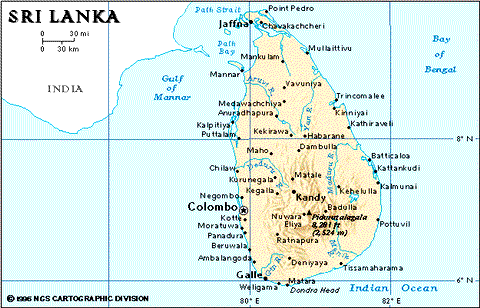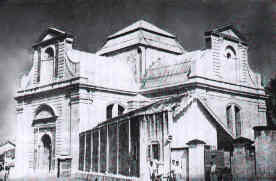
A brief history of the Dutch in Sri Lanka (Ceylon)
The Portuguese conquered the coastal areas of the island in the early 16th century and introduced the Catholic religion. By the mid 17th century the Dutch had taken over the Portuguese possessions and the rich spice trade. The Dutch East India Company became the most powerful force in the region having a monopoly on trade. Its purpose was not only trade but the prevention of other European nations from entering the region. During its history of 200 years it became the largest company of it's kind. In 1795 the Dutch possessions were occupied by the British, who made the island a crown colony in 1798. In 1815 the island was brought under one rule for the first time when the central area, previously under the rule of the King of Kandy, was conquered. The constitution of 1931 granted universal adult suffrage. Full independence was granted on Feb 4th 1948, with Dominion status in the British Commonwealth.

The flag of The Dutch East India Company (VOC)
The Dutch Burghers :
The families were part of a small community in Sri Lanka called "Dutch Burghers". The Dutch Burghers were descendants of those who served with the Dutch East India Company(V.O.C) in Sri Lanka. They were a distinct community who were English speaking Christians (Dutch Reformed Church mainly) and kept most of the Dutch customs. Only 900 hundred families of the V.O.C. people elected to stay in Sri Lanka when the British took over in 1796 Most Dutch colonists went back to the Netherlands.
Birth Deaths and marriages were recorded in the official genealogies of The Dutch Burgher Union of Ceylon (Sri Lanka). As was the Landsberger family and many of those that they married into. People needed to register their births and marriages as full citizenship and the ability to work for the V.O.C. was only given to those who could prove that they had at least three European grandparents. A large proportion of the Landsbergers worked in administration for the Dutch and when the British replaced the Dutch in influence, they found employment with the British Colonial Public Service as did a lot of other burgher families. The Dutch Burghers were very active in Government, business and the professions in both the Dutch and British colonial periods.
After WW 2 many of the remaining Dutch Burghers emigrated to Australia, England and the United States.
Many Members of the Landsberger family were married in the Dutch Reformed Church, Wolvendaal, which was built in 1749 and was first used in 1757. It is built on a hill and once over looked the sea and city. Today it is in the middle of Colombo.

The Dutch Reformed Churh. Wolvendaal. Colombo
With thanks to Mascha Van Dort for the above photo and some of the historical notes.